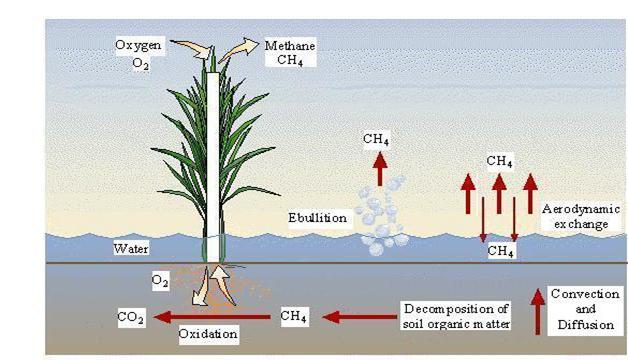Methane gas model
The conceptual model is described in Fig.
 Figure 5.5.Conceptual scheme of methane model
Figure 5.5.Conceptual scheme of methane model
Main input variables used in the process are given by the already existing structure. Soil organic matter provides the substrate useful for respiration by microbial biomass, which volumetric content is already calculated by CoupModel. Process rates are regulated by soil temperature and water content, which both influence microbial activity. Plant activity, in particular root water uptake and respiration, influences methane transport and oxidation.
Production, oxidation and transport of methane along the vertical soil column are described, taking into account three different transport mechanisms:
Advective flow and molecular diffusion through the soil pore space;
Transport by ebullition from the depth where bubbles are formed up to the water table and
Transport through plants from the soil region above the rooting depth directly to the atmosphere.
The model calculates methane concentration profiles in the soil and methane emissions to the atmosphere on a daily basis by numerically solving the 1-dimensional continuity equation within the vertical soil profile (Walter, 1996):
 (6.77)
(6.77)

where CCH4(t,z) is methane concentration at soil depth z and time t, D is the diffusion coefficient and CCH4net(t,z) is net methane source at depth z and time t.
The net methane source consists of a methane-production source (CCH4prod) and sinks by oxidation (CCH4ox), ebullition (CCH4ebull) and plant uptake (CCH4plant).
 (6.78)
(6.78)

Figure 5.6. Illustration of the different processes involved in the model
 Methane Production
Methane Production